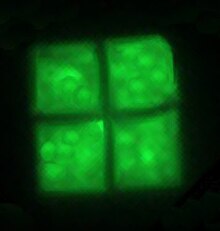Haloferacaceae is a family of halophilic, chemoorganotrophic or heterotrophic archaea within the order Haloferacales.[1][2][3] The type genus of this family is Haloferax.[4] Its biochemical characteristics are the same as the order Haloferacales.
| Haloferacaceae | |
|---|---|

| |
| Haloquadratum walsbyi | |
| Scientific classification | |
| Domain: | |
| Phylum: | |
| Class: | |
| Order: | |
| Family: | Haloferacaceae Gupta et al. 2015
|
| Genera | |
The name Haloferacaceae is derived from the Latin term Haloferax, referring to the type genus of the family and the suffix "-ceae", an ending used to denote a family. Together, Haloferacaceae refers to a family whose nomenclatural type is the genus Haloferax.
Taxonomy and molecular signatures
editAs of 2021, Haloferacaceae contains 10 validly published genera.[4] This family can be molecularly distinguished from other Halobacteria by the presence of five conserved signature proteins (CSPs) and four conserved signature indels (CSIs) present in the following proteins: thermosome, ribonuclease BN and hypothetical proteins.[1]
Phylogeny
editThe currently accepted taxonomy is based on the List of Prokaryotic names with Standing in Nomenclature (LPSN)[5] and National Center for Biotechnology Information (NCBI).[6]
| 16S rRNA-based LTP_08_2023[7][8][9] | 53 marker proteins based GTDB 07-RS207[10][11][12] | ||||||||||||||||||||||||||||||||||||||||||||||||||||||||||||||||||||||||||||||||||||||||||||||||||||||||||||||||||||||||||||||||||||||||||||||||||||||||||||
|---|---|---|---|---|---|---|---|---|---|---|---|---|---|---|---|---|---|---|---|---|---|---|---|---|---|---|---|---|---|---|---|---|---|---|---|---|---|---|---|---|---|---|---|---|---|---|---|---|---|---|---|---|---|---|---|---|---|---|---|---|---|---|---|---|---|---|---|---|---|---|---|---|---|---|---|---|---|---|---|---|---|---|---|---|---|---|---|---|---|---|---|---|---|---|---|---|---|---|---|---|---|---|---|---|---|---|---|---|---|---|---|---|---|---|---|---|---|---|---|---|---|---|---|---|---|---|---|---|---|---|---|---|---|---|---|---|---|---|---|---|---|---|---|---|---|---|---|---|---|---|---|---|---|---|---|---|---|
|
|
See also
editReferences
edit- ^ a b Gupta, Radhey S.; Naushad, Sohail; Baker, Sheridan (2015-03-01). "Phylogenomic analyses and molecular signatures for the class Halobacteria and its two major clades: a proposal for division of the class Halobacteria into an emended order Halobacteriales and two new orders, Haloferacales ord. nov. and Natrialbales ord. nov., containing the novel families Haloferacaceae fam. nov. and Natrialbaceae fam. nov". International Journal of Systematic and Evolutionary Microbiology. 65 (Pt_3): 1050–1069. doi:10.1099/ijs.0.070136-0. ISSN 1466-5026. PMID 25428416.
- ^ Grant, William D.; Kamekura, Masahiro; McGenity, Terry J.; Ventosa, Antonio (2015-09-14). "Halobacteria class. nov". Bergey's Manual of Systematics of Archaea and Bacteria: 1. doi:10.1002/9781118960608.cbm00026. ISBN 9781118960608.
- ^ Oren, Aharon (2012-02-01). "Taxonomy of the family Halobacteriaceae: a paradigm for changing concepts in prokaryote systematics". International Journal of Systematic and Evolutionary Microbiology. 62 (2): 263–271. doi:10.1099/ijs.0.038653-0. ISSN 1466-5026. PMID 22155757.
- ^ a b "Family: Haloferacaceae". lpsn.dsmz.de. Retrieved 2021-06-27.
- ^ J.P. Euzéby. "Haloferacaceae". List of Prokaryotic names with Standing in Nomenclature (LPSN). Retrieved 2021-11-17.
- ^ Sayers; et al. "Haloferacaceae". National Center for Biotechnology Information (NCBI) taxonomy database. Retrieved 2022-06-05.
- ^ "The LTP". Retrieved 20 November 2023.
- ^ "LTP_all tree in newick format". Retrieved 20 November 2023.
- ^ "LTP_08_2023 Release Notes" (PDF). Retrieved 20 November 2023.
- ^ "GTDB release 07-RS207". Genome Taxonomy Database. Retrieved 20 June 2022.
- ^ "ar53_r207.sp_labels". Genome Taxonomy Database. Retrieved 20 June 2022.
- ^ "Taxon History". Genome Taxonomy Database. Retrieved 20 June 2022.